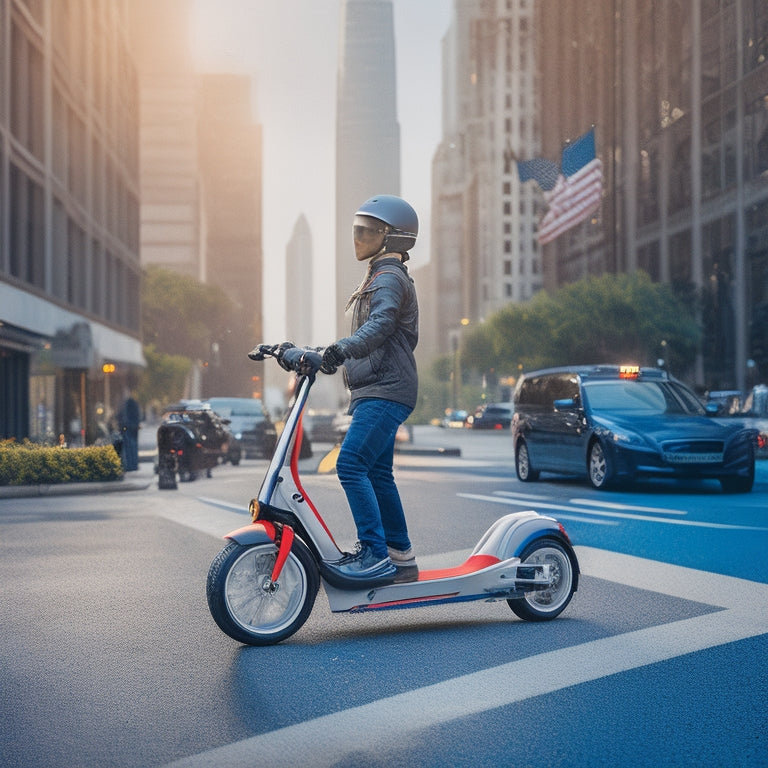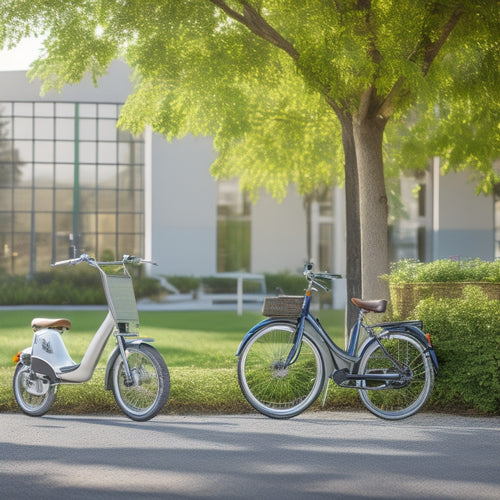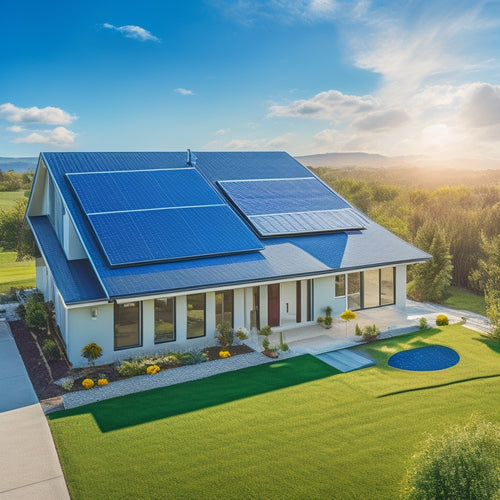
Mastering Electric Scooter Safety Regulations in the USA
Share
As you prepare to ride an electric scooter in the USA, understanding and complying with the complex web of federal, state, and local safety regulations is essential to ensuring a safe and enjoyable experience. You'll need to familiarize yourself with the U.S. Department of Transportation's guidelines, which set a maximum speed limit of 15.3 mph and mandate specific safety features like brakes, lights, and reflectors. Additionally, you'll need to check your state and local regulations, as they can vary greatly. To ride safely, you'll also need to wear protective gear, maintain your scooter regularly, and follow speed limits and zones. Now, get ready to dig deeper into the details that'll keep you safe on the road.
Key Takeaways
• The U.S. Department of Transportation (DOT) sets federal guidelines for electric scooter safety, including a maximum speed limit of 15.3 mph.
• State-by-state regulations vary, with some states like California allowing scooters on bike paths and sidewalks, while others like Florida rely on local laws.
• Helmets and protective gear, such as knee pads and elbow pads, are essential for rider safety, and reflective gear increases visibility.
• Speed limits vary by state and municipality, with rural roads allowing up to 25-30 mph and urban areas typically capping speeds at 15-20 mph.
• Regular maintenance, including battery checks, brake inspections, and tire pressure checks, is crucial to ensure safe scooter operation.
Understanding Federal Regulations
As you navigate the complex landscape of electric scooter safety regulations in the USA, you'll find that federal regulations play an important role in shaping the industry's standards and guidelines. At the federal level, the U.S. Department of Transportation (DOT) oversees the safety regulations for electric scooters. The DOT's supervision guarantees that manufacturers and operators comply with federal guidelines, which cover aspects such as vehicle design, safety features, and performance standards.
The Federal guidelines, set by the DOT, provide a framework for the industry to follow. For instance, the guidelines dictate the maximum speed limit for electric scooters, which is currently capped at 15.3 mph. Additionally, the guidelines specify the required safety features, such as brakes, lights, and reflectors.
The DOT also sets standards for the safety certification of electric scooters, ensuring that they meet specific safety criteria before they can be sold or operated in the USA. By understanding these federal regulations, you'll be better equipped to navigate the complex world of electric scooter safety regulations in the USA.
State-by-State Safety Laws
You'll encounter varying degrees of regulation at the state level, where laws and ordinances governing electric scooter safety differ greatly from one state to another. As you navigate the complex landscape of state-by-state safety laws, it's important to understand the nuances of each state's approach. Some states, like California, have enacted specific laws governing electric scooter use, while others, like Florida, have left regulation to local municipalities.
| State | Electric Scooter Regulations | Local Ordinances |
|---|---|---|
| California | Permitted on bike paths and sidewalks | Municipalities can create their own rules |
| Florida | No statewide regulations | Cities like Miami and Tampa have their own laws |
| New York | Permitted in NYC, restricted elsewhere | Municipalities can create their own rules |
In some cases, local ordinances and municipal policies can fill the gap where state laws are lacking. For instance, cities like Austin, Texas, have implemented their own rules for electric scooter use. It's important to familiarize yourself with the specific regulations in the areas you plan to ride, ensuring a safe and enjoyable experience for both riders and pedestrians.
Helmet and Protective Gear
Riding an electric scooter without proper protective gear can have devastating consequences, so it's essential to understand the role of helmets and other safety accessories in preventing injuries. As you ride, you're exposing yourself to potential head injuries, which can be severe and even fatal. That's why wearing a helmet is vital.
Here are the must-haves for your safety kit:
-
Helmets: A helmet is the most critical safety accessory for electric scooter riders. It protects your head from severe injuries in case of an accident.
-
Knee pads: Knee pads provide protection for your knees in case you fall off the scooter.
-
Elbow pads: Elbow pads offer additional protection for your elbows, which can get injured in a fall.
- Reflective gear: Wearing reflective gear, such as arm and leg bands, increases your visibility to other road users, reducing the risk of accidents.
Speed Limitations and Zones
Knowing the specific speed limits for electric scooters is important, as they can vary by state and even by municipality. Make sure to be aware of the zones where speed restrictions apply.
You'll want to familiarize yourself with rural road guidelines, which often have higher speed limits than urban areas. Typically, rural roads allow for speeds up to 25-30 mph, while urban speed limits are usually capped at 15-20 mph. Some cities have designated scooter lanes or zones with specific speed limits, so it's important to be mindful of these areas.
Additionally, be aware of pedestrian-heavy zones, such as school zones or tourist areas, where speed limits may be even lower. You should also be prepared for variable speed limits within a single municipality, as some areas may have different speed restrictions based on the time of day or road conditions.
Vehicle Maintenance Standards
Regular inspections and maintenance of your electric scooter are vital to guarantee it operates safely and efficiently, as faulty brakes, worn-out tires, or malfunctioning lights can lead to accidents or injuries. As an electric scooter owner, it's important to prioritize vehicle maintenance to ensure your safety and the safety of others on the road.
Here are some essential maintenance checks you should perform regularly:
- Battery checks:
- Check your battery's state of charge.
- Look for signs of wear and tear.
- Establish proper storage and charging practices.
- Brake inspections:
- Inspect your brakes for wear.
- Adjust or replace them as needed.
- Confirm proper brake function.
- Tire pressure and tread checks:
- Verify tire pressure is at the recommended level.
- Examine tread depth to ensure sufficient grip on the road.
- Light and signal checks:
- Confirm all lights, including headlights, taillights, and turn signals, are functioning correctly.
- Ensure lights are clean and free of debris.
Rider Age and License
In the United States, you must meet specific age and licensure requirements to legally operate an electric scooter on public roads, guaranteeing a safe and regulated environment for all road users. Most states require you to be at least 16 years old to ride an electric scooter, although some states have a minimum age requirement of 18. Additionally, you might need a valid driver's license or permit to operate an electric scooter, especially if it has a top speed exceeding 20-25 mph.
If you're under 18, you'll likely need parental consent to ride an electric scooter. This ensures that your parents or legal guardians are aware of the risks and responsibilities involved in riding an electric scooter. Teenage freedom is great, but it comes with rules and regulations to safeguard your safety and the safety of others on the road.
It's crucial to familiarize yourself with the specific laws and regulations in your state or local jurisdiction to avoid any legal issues or penalties.
Manufacturer Safety Certifications
As you explore the world of electric scooter safety, you'll encounter various manufacturer safety certifications that guarantee riders' protection.
You'll need to understand the significance of UL certification requirements, CPSC compliance standards, and ASTM testing procedures.
UL Certification Requirements
Obtaining UL certification is an essential step for electric scooter manufacturers, as it guarantees their products meet rigorous safety standards and provides consumers with assurance of a safe riding experience. As a manufacturer, you'll need to go through a certification process that involves rigorous testing and inspections.
Here are the key steps you'll need to take:
-
Application and Quotation:
You'll need to submit an application and receive a quotation for the certification process. -
Certification Process:
UL will review your product design, conduct testing, and inspect your factory to verify compliance with safety standards. -
Factory Inspections:
Regular factory inspections will be conducted to confirm ongoing compliance with UL standards.
-
Certification and Ongoing Surveillance:
Once certified, you'll need to undergo regular surveillance audits to uphold your certification.
CPSC Compliance Standards
You must adhere to the Consumer Product Safety Commission's (CPSC) guidelines, which require manufacturers to guarantee their electric scooters meet specific safety standards and regulations. As a manufacturer, you're responsible for ensuring your products comply with CPSC standards, which cover various aspects of electric scooter design, production, and distribution.
One important aspect of CPSC compliance is labeling requirements, which dictate what information must be displayed on the scooter and its packaging. You'll need to include details such as warnings, instructions, and certifications, making sure that consumers are well-informed about safe usage and potential hazards.
In addition to labeling, you'll need to comply with CPSC's packaging guidelines, which outline specific requirements for secure and protective packaging. This includes making certain that the scooter is properly secured within the packaging, and that the packaging itself is durable and resistant to damage during transportation and storage.
ASTM Testing Procedures
To guarantee the safety and reliability of your electric scooters, you must subject them to rigorous testing procedures outlined by the American Society for Testing and Materials (ASTM), which provides manufacturers with a standardized framework for evaluating their products' performance and safety features.
ASTM testing procedures secure that your scooters meet the required safety standards, giving you and your customers peace of mind. Here are some key aspects of ASTM testing:
-
Material selection: ASTM testing evaluates the durability and reliability of the materials used in your scooters, ensuring they can withstand various environmental conditions.
-
Testing protocols: ASTM outlines specific testing protocols for evaluating scooter performance, including braking systems, stability, and electrical components.
-
Impact resistance: ASTM testing assesses the scooter's ability to withstand impacts, ensuring that it can absorb shocks and protect riders in the event of an accident.
- Electrical safety: ASTM testing verifies that your scooters meet electrical safety standards, minimizing the risk of electrical shocks or fires.
Frequently Asked Questions
Can I Ride an Electric Scooter on Sidewalks in All States?
"When you hop on your e-scooter, remember that sidewalk riding rules vary by state and even city, so you'll need to know local ordinances and practice good sidewalk etiquette to avoid a nasty fine or worse, an accident."
Do Electric Scooters Require License Plates or Registration?
You'll need to check state-specific regulations, as electric scooters' vehicle classification varies, affecting registration requirements and fees, with some states requiring plates and others exempting them, creating compliance issues due to state variances.
Are Electric Scooters Allowed in National Parks and Forests?
"Sorry to burst your adventure bubble, but you can't just ride your electric scooter into national parks and forests; rules vary, but most forest trails and wilderness areas are off-limits, so check with park rangers before you ride."
Can I Carry a Passenger on an Electric Scooter?
When riding an e-scooter, you shouldn't carry a passenger, as most scooters aren't designed for two riders, compromising Scooter Design and Rider Etiquette, and potentially causing accidents due to imbalance and reduced stability.
Are There Specific Rules for Electric Scooters on College Campuses?
Are you thinking, "Do I need to follow special rules on campus?" Yes, you do! Campus Governance often sets specific regulations for electric scooters, ensuring Student Access while prioritizing safety, so be sure to check with your college administration for guidelines.
Related Posts
-

Top Picks: Van-Friendly Panel Kits to Buy Online
You're about to hit the open road, and you need a reliable source of power to keep your van's essentials running smoo...
-

What Are the Best Eco-Friendly Rides for Campus?
As you navigate your college campus, you have a wide range of eco-friendly ride options to choose from, including bic...
-

5 Best Steps to Installing Solar Panels at Home
You're about to start on a journey to harness the power of solar energy at home. First, assess your home's solar pote...


